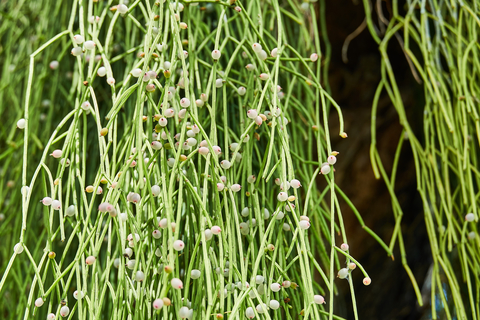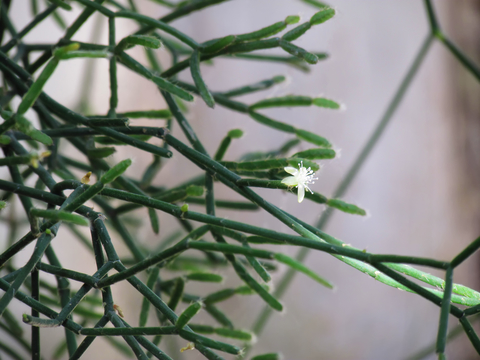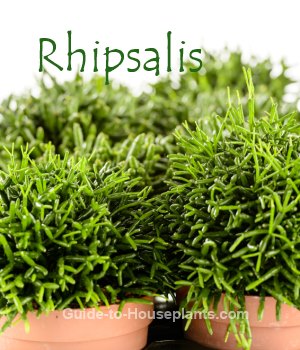Mistletoe Cactus
Botanical Name: Rhipsalis baccifera and other species
Spiky, branched stems punctuating the air makes mistletoe cactus an exciting plant for any room. Some species are more weeping than others, trailing over the sides of the pot. Put one in a hanging basket to show it off at eye-level.
 Rhipsalis baccifera growing on a tree in its native Guyana, South America. Photo: © Thenatureguy1
Rhipsalis baccifera growing on a tree in its native Guyana, South America. Photo: © Thenatureguy1Its long, cylindrical stems are jointed, branching naturally. You won't need to prune it, unless you want.
Handle the plant carefully -- those stems are fragile and may break off at the stem joints.
You can expect small greenish-white flowers to appear in late winter or spring, followed by white fruits that look similar to the berries on mistletoe. You'll often find this plant labeled Mistletoe Cactus.
Tropical Beginnings
Although this is a true cactus, its origins are in the tropical rain forests, where Rhipsalis makes its home as an epiphyte, hanging on a tree branch. Forget what you think you know about cacti, this one is a jungle native and needs high humidity and indirect sunlight.
 Tiny, white flowers are soon replaced by white berries. Photo: © Prispim
Tiny, white flowers are soon replaced by white berries. Photo: © PrispimMistletoe Cactus Problems, Solutions and Answers
Wondering when to repot? Repot every couple years, keeping this sprawling succulent in a smallish pot. Wait till the spring flowers have faded -- never repot a plant while it's blooming.
Shriveled, reddish stems are caused by too much sunlight. Shade mistletoe cactus from hot, direct sunlight, especially in summer.
No blooms? Provide plenty of bright, indirect light. Fertilize your plant to encourage flowering.
Is Rhipsalis baccifera poisonous? No. It's non-toxic for cats and dogs.
 Despite its tropical beginnings, Mistletoe Cactus adapts well as a houseplant.
Despite its tropical beginnings, Mistletoe Cactus adapts well as a houseplant.Mistletoe Cactus Care Tips

Origin: Brazil and Peru
Height: Varies by species; many will trail to 6 ft/1.8 m indoors, unless pruned back.
Light: Bright indirect light year-round. Shade from direct sunlight, especially in summer, which causes the stems to turn red and look shriveled. This tropical cactus thrives under indoor grow lights.
Water: In spring and summer, allow the potting medium to dry out slightly between waterings; water less in winter.
Humidity: This cactus is native to rain forests where it lives with high humidity. Indoor air can become extremely dry in winter, so it's a good idea to use a humidity gauge and maintain 50% relative humidity around the plant; this is easier than it seems. Discover ways to increase humidity for your houseplants.
Temperature: 70-75°F/21-24°C days and 60-70°F/16-21°C nights
Soil: Mix 1 part peat moss-based potting mix and 1 part fine-grade fir bark. Don't pack the potting medium down. An epiphyte in its native habitat, this cactus likes a little air around its roots.
Fertilizer: Feed once a month with a fertilizer specially made for cacti and succulents.
Propagation: Use a sharp, clean knife, scissors or a razor blade to take stem cuttings. A milky, white sap may ooze from the cuttings, so allow the cut ends to dry for a day or two. Then insert the cut end into a sterile potting medium. Keep the medium lightly moist.


